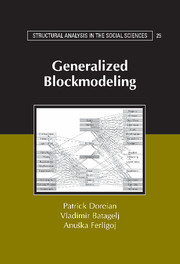Book contents
- Frontmatter
- Contents
- Preface
- 1 Social Networks and Blockmodels
- 2 Network Data Sets
- 3 Mathematical Prelude
- 4 Relations and Graphs for Network Analysis
- 5 Clustering Approaches
- 6 Optimizational Approach to Conventional Blockmodeling
- 7 Foundations for Generalized Blockmodeling
- 8 Blockmodeling Two-Mode Network Data
- 9 Semirings and Lattices
- 10 Balance Theory and Blockmodeling Signed Networks
- 11 Symmetric–Acyclic Blockmodels
- 12 Extending Generalized Blockmodeling
- Bibliography
- Author Index
- Subject Index
- Titles in the series
5 - Clustering Approaches
Published online by Cambridge University Press: 13 January 2010
- Frontmatter
- Contents
- Preface
- 1 Social Networks and Blockmodels
- 2 Network Data Sets
- 3 Mathematical Prelude
- 4 Relations and Graphs for Network Analysis
- 5 Clustering Approaches
- 6 Optimizational Approach to Conventional Blockmodeling
- 7 Foundations for Generalized Blockmodeling
- 8 Blockmodeling Two-Mode Network Data
- 9 Semirings and Lattices
- 10 Balance Theory and Blockmodeling Signed Networks
- 11 Symmetric–Acyclic Blockmodels
- 12 Extending Generalized Blockmodeling
- Bibliography
- Author Index
- Subject Index
- Titles in the series
Summary
Regardless of whether old methods are used or new methods are created, all efforts to blockmodel social networks involve clustering. It is useful, then, to consider some the many tools and ideas that have been created by cluster analysts. We describe the essential ideas and discuss a variety of methods that have value for clustering social networks. With regard to conventional blockmodeling concerns, the materials in Sections 5.1–5.4 are essential. Readers can move directly to Chapter 6 from the end of Section 5.4. In Section 5.5 a nonstandard approach of simultaneously clustering attribute and relational (network) data is discussed.
AN INTRODUCTION TO CLUSTER ANALYTIC IDEAS
Grouping units into clusters so that those within a cluster are as similar to each other as possible, whereas units in different clusters are as dissimilar as possible, is a very old problem. Many different (partial) solutions have been proposed. Although the clustering problem is intuitively simple and understandable, providing general solution(s) is difficult and remains a very current activity. New data sets and new problems provide the impetus for finding more solutions. The increasing number of recent papers on this topic, in both theoretical and applied statistical journals, is notable.
There are two main reasons for this lively interest and the creation of many new procedures in this area. First, prior to 1960, clustering problems were solved separately in different scientific fields with little concern for integration across specific solutions – a characteristic of the early stages in the development of any discipline. Attempts to unify different problems and solutions first appeared in the 1960s, with Sokal and Sneath (1963) providing the first extensive statement.
- Type
- Chapter
- Information
- Generalized Blockmodeling , pp. 133 - 167Publisher: Cambridge University PressPrint publication year: 2004



